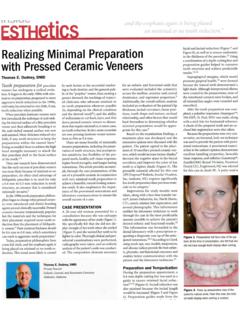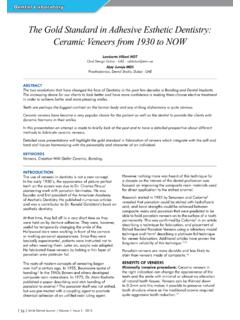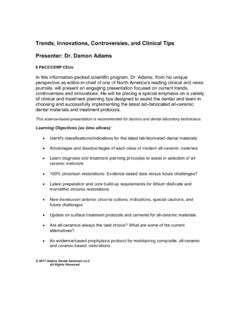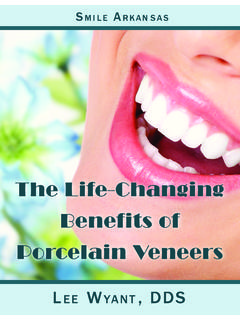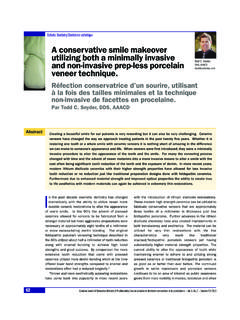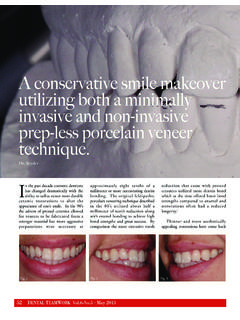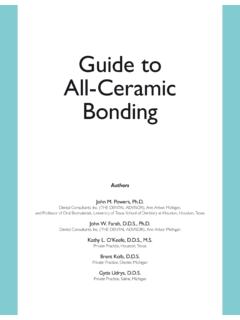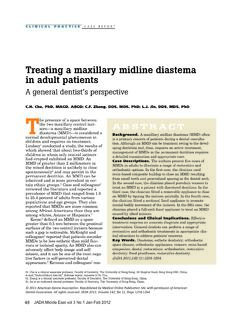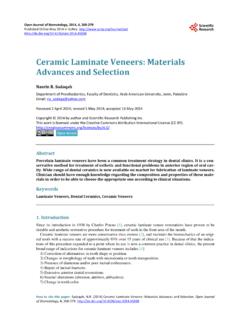Transcription of and Pressed Porcelain Veneers - Dental CE Courses
1 66 Spring 2012 Volume 28 Number 1 67 Journal of Cosmetic Dentistry Adolfi/FradeaniAs responsible clinicians and ceramists, we are constantly searching for the best treatment options to deliver high-quality restorations to our patients. We all strive to create a delicate balance between hard and soft tissue for a synergistic outcome. New materials make it increasingly possible for us to present less invasive alternatives. In a quest for answers, the jCD asked distinguished educators Dr. Dario Adolfi and Dr. Mauro Fradeani to share their thoughts regarding the myths and realities of feldspathic stacked Porcelain Veneers and Pressed Porcelain Veneers . Their comments will enlighten you, either providing another way of looking at this topic, or confirming what you already Stacked Porcelain Veneers and Pressed Porcelain VeneersDario Adolfi, DDS, CDTM auro Fradeani, DDS 68 Spring 2012 Volume 28 Number 1Dr. Adolfi Dispels Myths Regarding Feldspathic Stacked VeneersThe use of laminate Veneers is among the most documented approaches in the Dental literature for improving smiles.
2 One of the advantages of this material is the potential to obtain high-quality restorations that achieve a perfect harmony between soft and hard tissues. This is due to the physical properties of the ceramic, which remains stable over time even inside an environment as adverse as the oral cavity. To achieve success and stability, bonding procedures must be planned and conducted carefully, leading to a perfect sealed interface between the tooth and achieve a bonding interaction between Dental hard tissue and ceramic, the structures must be capable of being altered to receive a material that combines the surfaces, thus creating a perfect The adhesive ability of the restorative material to be bonded to tooth structure is referred to as biomimetic. 2 One of the advantages of this material is the potential to obtain high-quality restorations that achieve a perfect harmony between soft and hard tissues. 69 Journal of Cosmetic Dentistry MythStacked feldspathic Veneers lead to periodontal issues because they are usually Veneers should always be avoided, because they may appear Therefore, prominent cervical contours must be carefully flattened to avoid over-contouring the final , when the Veneers are placed without prepa-ration, periodontal problems can occur as a result of over-contoured teeth with unnatural emergence For no-preparation Veneers , the esthetic results are variable; some of these restorations can appear too bulky and over-contoured,6 while others have relative-ly acceptable ,6A wax-up is indispensable for every esthetic den-tal plan.
3 For cases where a minimal preparation is planned, the procedure must be done with the addi-tive technique. Prior to planning a wax addition, the dentist must carefully consider the initial evaluation of the case, which addresses the teeth s characteristics, the patient s smile, patient s age, opposite arch, and gingival maintain a tooth s original shape, a clinician is often required to remove a slight to moderate amount of enamel when making Some clini-cians feel that a more optimal esthetic potential can be achieved when teeth are prepared with a light cham-fer, especially at the gingival margin, which arguably prevents over-contouring in that region (Figs 1-2b).8In the laboratory, it is very difficult to fabricate a veneer less than mm Therefore, to preserve the health of the gingival tissues and prevent over-contouring, a slight reduction of tooth sur-face has been found to work Because feldspathic Veneers are typically mm, the lost tooth structure is replaced and the original emergence profile is near-ly After cementation, the laminate Veneers should mimic the patient s natural dentition (Fig 3).
4 However, in a study comparing teeth restored with Porcelain Veneers , both with and without preparation, it was reported that there were no differences in terms of periodontal 1: Preoperative image of the anterior teeth showing extensive composite restorations. Figures 2a & 2b: Facial and incisal views of minimal preparations with a light chamfer finish line; this practice guarantees correct tooth morphology and a natural emergence profile. Adolfi 71 Journal of Cosmetic Dentistry MythFeldspathic Veneers are weak Porcelain restorations that are more prone to failure due to chipping and fracture than Pressed clinicians face difficulties during try-in and bonding procedures with feldspathic Porcelain ve-neers. A major concern is their strength, which is only approximately 70 MPa to 90 MPa,11 making feldspath-ic Veneers more prone to failure before bonding than Pressed Veneers . The development and improvement of pressable lithium disilicate material with flexible strength of approximately 400 MPa has reintroduced the concept of less preparation for laminate Veneers .
5 Lithium disilicate permits the technician to build a Pressed restoration as thin as mm while still en-suring a strength of 400 MPa (Fig 4). This ceramic can be carefully reduced, using rub-ber wheels and special burs, to less than mm with proper resistance. Consequently, it can be placed and bonded with much less risk compared to traditional Porcelain , which is made via the refractory die The final morphology of the restorations is injected with lithium disilicate, and all the character-ization (fixation) is performed. The color and fitting can be evaluated and modified during the try-in pro-cedures, with low risk of compromising the strength or fitting after many bakes. After fixation, two layers of glaze powder are applied to protect the characteriza-tion. Lithium disilicate is indicated for Veneers with conventional preparation or no preparation to im-prove the esthetics and reestablish the anterior guid-ance (Figs 5a-6c). The disilicate-based materials maxi-mize these benefits for laboratories and 4: When placing the 10 lithium disilicate Veneers in sequence and using special illumination, the thinness of the restorations is 5a & 5b: Enamel defects across the surfaces of the anterior maxillary and mandibular incisors.
6 Note the diastemas between teeth and the discrete excess gingival tissue in the mandibular premolar areas. Adolfi 72 Spring 2012 Volume 28 Number 1 MythFeldspathic porcelains are too translucent to block out discolored laminate Veneers cannot easily mask severe staining and discoloration (such as severe tetracycline staining)12 without adding thickness to the Veneers . If thin Veneers are constructed, the final result in these cases is often compromised due to the use of underly-ing opaque Porcelain ; the Veneers typically exhibit a very high value and lack of discrepancy is due to the veneer s relative thinness and opaque quality; light passing through it can make the color of the underlying preparation show If the patient requests a significant shade change, the dentist must overcome the color discrepancy by deepening the preparation and increas-ing the thickness of the ,13,14 This enables the technician to block out the underlying tooth color and achieve the desired color change (Figs 7 & 8).
7 12 MythThe contraction stress generated from curing the adhe-sive composite or cement used for bonding the resto-ration can fracture a feldspathic fixing a restoration in place, an important function of Dental luting cements is to seal the gap between tooth and restoration. However, as a result of adhesion, curing contraction is hindered, creating stress. Shrinkage stress in composite restorations, gener-ated during setting, continues to be a major problem in adhesive ,16 Excessive shrinkage stress on the tooth cusps, caused by wall-to-wall contraction, may lead to cuspal distortion, marginal discrepancies, postoperative hypersensitivity, and ,18 Indirect, esthetic, bonded restorations can overcome these problems by limiting contraction stress of the polymerization reaction to the thin resin-cement ,20 It is logical to assume that interfacial stresses will then be reduced for composites cured in cavities with minimally constrained surface A ceramic that is sufficiently and evenly thick, combined with a mini-mally thick luting composite, will provide the resto-ration with a favorable configuration and reduce the likelihood of 6a-6c: Final result after cementation.
8 Note the tissue integration and importance of canine guidance to maintain occlusal stabilization. 73 Journal of Cosmetic Dentistry ConclusionMedium- to long-term maintenance of Porcelain ve-neer esthetics is excellent, patient satisfaction is high, and feldspathic Porcelain Veneers and lithium disili-cate material have no adverse effects on the gingival health of patients with optimal oral hygiene. An optimal bonded restoration can be achieved, es-pecially if the preparation is located completely in the enamel, correct adhesive procedures are carried out, and a suitable luting composite is Based upon their high esthetic value and minimal prepara-tion requirements, these materials allow dentists and technicians to provide esthetic treatments that are much less invasive which is precisely what patients 7: A lateral incisor with severe discoloration after endodontic 8: This final result was achieved due to deep preparation, which produced a veneer with adequate thickness.
9 Selecting an appropriate shade of luting resin cement is important to obtain satisfactory esthetic Adolfi D, Andrade OS. Lithium disilicate Veneers : a case report with no teeth preparation. Spectr Dialogue. 2011;10(9) Magne P, Belser UC. Bonded Porcelain restorations in the ante-rior dentition: a biomimetic approach. Hanover Park (IL): Quin-tessence Pub.; Christensen GJ. Facing the challenges of ceramic Veneers . J Am Dent Assoc. 2006 May;137(5) Strassler HE. Minimally invasive Porcelain Veneers : indications for a conservative esthetic dentistry treatment modality. Gen Dent. 2007 Nov;55(7):686-94; quiz 95-6, DeLopez TE. Predictable Pressed ceramic anterior restorations: clinical observations. Dent Today. 2002 Apr;21(4) Christensen GJ. Has tooth structure been replaced? J Am Dent Assoc. 2002 Jan;133(1) Gurel G. The science and art of Porcelain laminate Veneers . Hanover Park (IL): Quintes-sence Pub.; 2003. Adolfi 75 Journal of Cosmetic Dentistry Dr. Adolfi is the director of Spazio Education in S o Paulo, Brazil.
10 He also has a private practice in S o : The author did not report any optimal bonded restoration can be achieved, especially if the preparation is located completely in the enamel, correct adhesive procedures are carried out, and a suitable luting composite is McLaren EA. Porcelain veneer preparations: to prep or not to prep. Inside Dent. 2006;2(4) DiMatteo AM. Prep vs. no-prep: the evolution of Veneers . Inside Dent. 2009;5(6) Yu X, Oullet D, Ibsen R. Perio evaluation of long-term prep versus non-prep Porcelain veneer restorations. J Dent Res. 1998;77(Spec. Iss.) Giordano R. A comparison of all-ceramic restorative systems. J Mass Dent Soc. 2002 Winter;50(4) Javaheri D. Considerations for planning esthetic treatment with Veneers involving no or minimal preparation. J Am Dent Assoc. 2007;138(3):331-7. 13. Dozic A, Kleverlaan CJ, Meegdes M, van der Zel J, Feilzer AJ. The influence of Porcelain layer thickness on the final shade of ce-ramic restorations. J Prosthet Dent.

